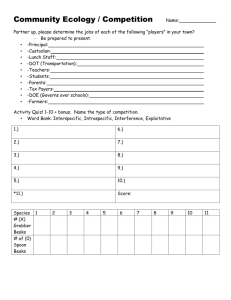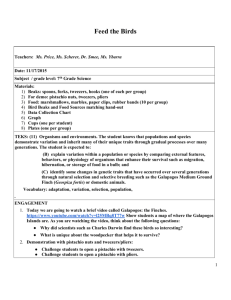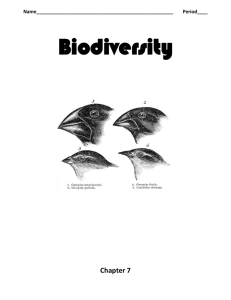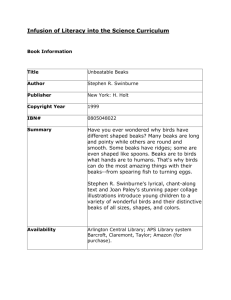Bird Beaks
advertisement
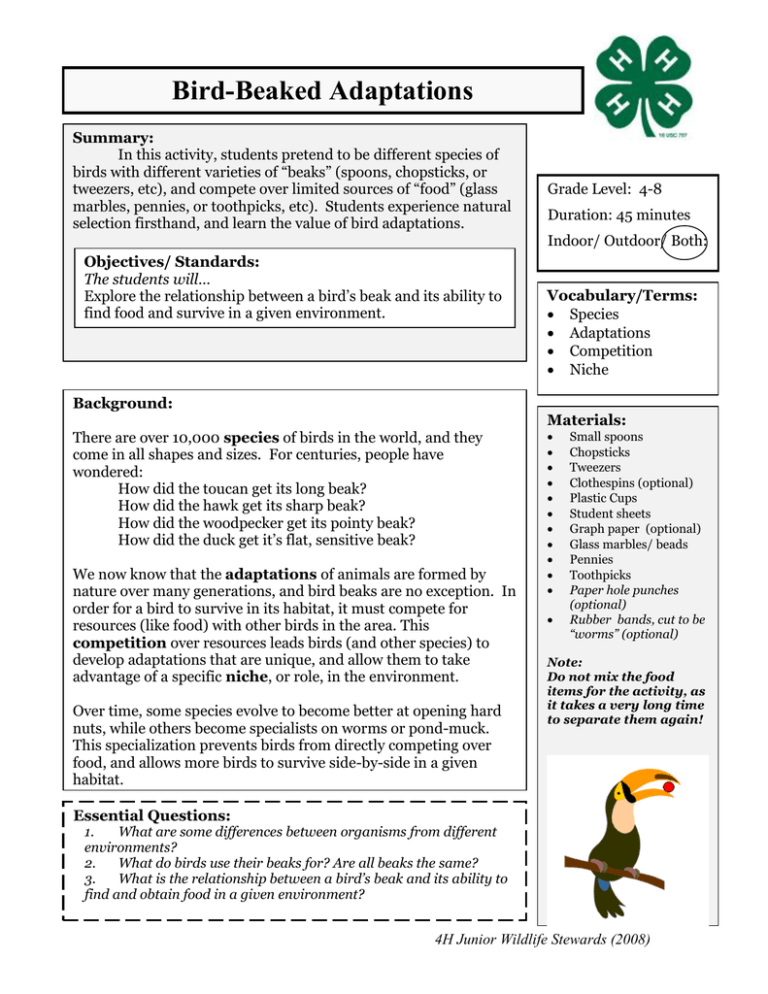
Bird-Beaked Adaptations Summary: In this activity, students pretend to be different species of birds with different varieties of “beaks” (spoons, chopsticks, or tweezers, etc), and compete over limited sources of “food” (glass marbles, pennies, or toothpicks, etc). Students experience natural selection firsthand, and learn the value of bird adaptations. Grade Level: 4-8 Duration: 45 minutes Indoor/ Outdoor/ Both: Objectives/ Standards: The students will… Explore the relationship between a bird’s beak and its ability to find food and survive in a given environment. Background: Vocabulary/Terms: Species Adaptations Competition Niche Materials: There are over 10,000 species of birds in the world, and they come in all shapes and sizes. For centuries, people have wondered: How did the toucan get its long beak? How did the hawk get its sharp beak? How did the woodpecker get its pointy beak? How did the duck get it’s flat, sensitive beak? We now know that the adaptations of animals are formed by nature over many generations, and bird beaks are no exception. In order for a bird to survive in its habitat, it must compete for resources (like food) with other birds in the area. This competition over resources leads birds (and other species) to develop adaptations that are unique, and allow them to take advantage of a specific niche, or role, in the environment. Over time, some species evolve to become better at opening hard nuts, while others become specialists on worms or pond-muck. This specialization prevents birds from directly competing over food, and allows more birds to survive side-by-side in a given habitat. Small spoons Chopsticks Tweezers Clothespins (optional) Plastic Cups Student sheets Graph paper (optional) Glass marbles/ beads Pennies Toothpicks Paper hole punches (optional) Rubber bands, cut to be “worms” (optional) Note: Do not mix the food items for the activity, as it takes a very long time to separate them again! Essential Questions: 1. What are some differences between organisms from different environments? 2. What do birds use their beaks for? Are all beaks the same? 3. What is the relationship between a bird’s beak=and its ability to Limited resources + different adaptations selective find and obtain food in a given environment? survival 4H Junior Wildlife Stewards (2008) Set-up: Ask Students if they can identify some different adaptations animals have to survive in their environment: What do these adaptations do? In what ways do they help the animal obtain its basic needs? Could this animal live very well in a different environment? Procedure: Discuss beaks. Show pictures of a variety of birds that occupy different niches often eat different foods and have different types of beaks: What are some examples of different bird beaks? What are these beaks best suited for? Can you tell what a bird might eat just by looking at its beak? Demonstrate examples of the usefulness of bird beaks by showing the class some common tools that might do the same job: A Hawk’s beak is like a pair of scissors or snips. A Woodpecker’s beak is like an awl and tweezers A Duck’s beak is like a strainer A Parrot’s beak is like a nutcracker Notes: The Activity: 1. Tell students that they will get to test out different models of bird beaks to see which are most effective in grabbing different types of food. One by one, show the “food” items to students and have them think of real food they could represent for birds: A marble could represent a hard nut A toothpick could be an insect A penny could be a clam, etc 2. Next, one-by-one, show them the different beak-type tools and ask them to think of a real bird that has a similar type of beak. A Chickadee has a small beak like tweezers A Seagull has a larger bill like chopsticks A duck or spoonbill has a beak kind of like a spoon 3. Divide students into 3-5 groups and seat the groups in different areas of the classroom. Tell students that in this activity they are to pretend that they are birds. Students will each have one beak type (which they must keep throughout that round) and a cup (to represent the bird’s stomach) and will l attempt to pick up various types of food out of a tray at timed intervals (1-2 minutes each). Emphasize that they can use only that beak for eating, and cannot move the tray of food. They should hold the beak in one hand and the stomach (plastic cup) in the other hand. 4H Junior Wildlife Stewards (2008) 4. Review the rules. Have students explain the rules back to you. Make sure they understand what to do during the rounds, and between the rounds. Make sure they know that they will exchange beaks, so they will get to try all of the beaks. Explain that you will be the timekeeper. You will call "go" and “stop” at the end of each round. 5. Hand out various types of bird-beaks to students at each “island”. Place one type of food in each tray and tell students that when you say “Go,” they should feed for 1-2 minutes or until all the food is gone. Students should count the contents of their cup, record their data on the data sheet, and exchange beaks within the group. Repeat with a different food item, so groups get to try all of the food items. Wrap-up: Assessment (how will students demonstrate their understanding?): Which of the beak types feed most successfully on which food times? What do you think would happen if all birds had the same beaks? Was one beak type successful with more than one food item? Did your earlier observations about beak types help you to understand how birds feed? Extensions A. Allow students to design their own bird beaks, using materials you supply in class. Allow them to test and refine their beaks before you play the activity again. Materials could include clothespins, rubber bands, chopsticks, Popsicle sticks , spoons, forks, toothpicks, etc. Encourage them to use at least 2-3 items to make their beaks. B. (Competitive version) Divide the class into 3-5 groups, have each group sit apart from the others, and place a tray in the middle of each group. Explain that these trays represent islands, and the students around the tray represent the species of birds that live on each island. Each island hosts a different kind of food that is only found on that island, and during the round, the birds on the island can only fill their bellies from the food at that island. At the end of each round, birds must record their data on the data sheet. Then the birds must decide if they want to: 1. Make their home on that island and continue collecting that same type of food 2. Evolve (or change to) a new bird beak, or 3. Fly off to another island and take their chances with another type of food Birds may fly to a new island each round, and may re-visit any island they want, or they may chose to stay when they find an island they like best. The goal for each bird is to obtain the most number of food items (of any kind) by the end of 5 rounds. Remind students that this is a competition, so they may not “give away” any secrets they discover in the course of the game (e.g. which beak works best fore which type food). The goal is to get as many items as possible in your belly (cup) in 5 rounds. At the end of the game, notice where students are located. 4H Junior Wildlife Stewards (2008) Relevant Books:

